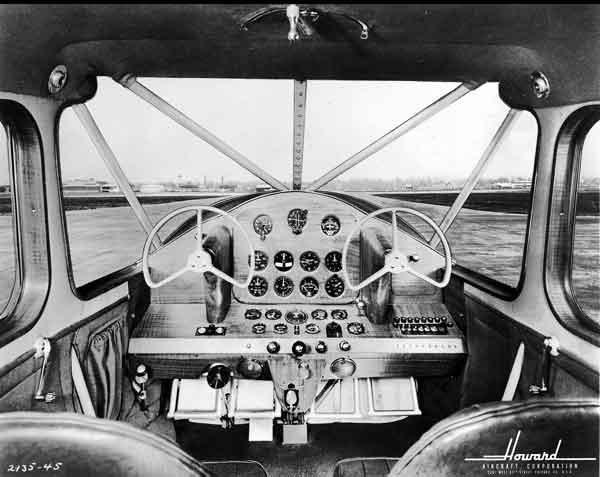Chet’s Howard DGA-15, NC-2464, S/N 503. Both of these photos (and the cockpit photo below) were taken by Howard Aircraft for their sales brochure and other literature. Much of the information, the Canadian photos and that sales brochure are furnished courtesy of Mr. Ken Kreutzfeld of K&M Restorations, who is currently restoring this aircraft.)
In the early summer of 1939, Chet had his eye on another Waco to replace his ZQC-6. By the fall Chet had changed his mind and in November he purchased a Howard DGA-15J to be the fourth and last of the “Son-Dot” planes. The DGA-15 was the last in the series from Howard Aircraft Corporation. Benny Howard had “rocketed” to fame in the aviation world when his “Mr. Mulligan” plane (a DGA-6) blitzed the 1935 National Air Race. The DGA series (which Howard co-designed with Gordon Israel) were well built performers.

Chet’s plane was an early DGA-15 (S/N 503, the prototype was S/N 500.) He flew his Howard into several SPA events in the early 1940’s, including the 1940 S.P.A. cruise to White Sulphur Springs, West Virginia, around the time when Sam Snead was a course professional there.
Howard was located in Chicago, where Chet moved back to in 1940 to head the Vulcan Iron Works. The airplane even influenced that concern. Most government sites tell us that DGA stands for “darned good airplane,” although the truth is stronger than that. When Vulcan introduced its “portable pile hammer” in the mid-1950’s, it named the hammer “DGH”!
It’s also interesting to note that Benny Howard flew as a pilot for United. Even though Chet flew his own aircraft extensively, in 1941 he was made a member of the United Air Lines 100,000 mile club. Although we have people today (perhaps yourself) who fly millions of miles on commercial aircraft, in 1941 100,000 miles was a great deal of flying.
More information on the Howard aircraft can be found at the Howard Aircraft Foundation site.
| Specifications | Performance | ||||
| Wingspan | 38′ | 11.6 m | Maximum Speed | 178 mph @ 4000 ft. | 286.5 kph @ 1219 m |
| Length | 25′ | 7.6 m | Cruising Speed | 165 mph @ 8000 ft. | 191 kph @ 2591 m |
| Height | 8.5′ | 2.6 m | Landing Speed | 61 mph | 98 kph |
| Wing Area | 210 sq. ft. | 19.5 sq. m. | Service Ceiling | 15,500 ft | 4722 m |
| Wing Loading | 20.7 psf | 103.3 kg/sq. m. | Range | 1280 mi. | 2060 km |
| Power Loading | 14.5 lb/hp | 6.57 kg/hp | Engine | ||
| Empty Weight | 2500 lbs. | 1134 kg. | Type | Jacobs L-6MB | |
| Payload | 805 lbs. | 365 kg. | Rated Power | 300 hp @ 2100 rpm @ 3700 ft. (1127.8 m) | |
| Gross Weight | 4350 lbs. | 1973 kg. | Standard Equipment | ||
| Baggage | 125 lbs. | 57 kg. | Hamilton Standard propeller, Eclipse starter, tail wheel, brakes, parking brake, navigation and landing lights, battery | ||
| Fuel | 118-151 gals. | 447-571 litres | |||
| Oil | 8 gals. | 32 litres | Instruments | Full complement of flight and engine instruments. | |
| Airfoil Type |
Wing
|
NACA 2R2 12 |
Tail
|
NACA
2R2 12 |
|
NC-2464 has an interesting subsequent history. In August 1941 Chet sold the plane to Wings Field in Ambler, Pennsylvania. They subsequently resold the plane to Donald Spencer, who took it to Nicaragua. It returned to the U.S. after it was sold again to T.R. Jones of Dallas, Texas in 1944. It went through a series of owners in the U.S. and Canada, and for a while sported pontoons.
Airborne and not so airborne: photos from the Howard’s Canadian years in the early 1980’s. Its Canadian registration was C-FLRM. While in Canada the Howard found earth prematurely. Chet has his own mishap in the Howard: at 1230 1 April 1940, it crashed in Greensboro, NC, which required the replacement of a wing and the right hand elevator, along with other repairs.
The plane returned to the U.S. and its current owner in 2001.

